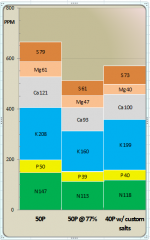Spurr what jargon are they spinning here?
Advanced Nutrients use very low levels of amino proteinates (glycine bonded M ions = 2 mol glycine to 1 mol M ion) for chelated micro nutrients along with much higher levels of EDTA chelated micro elements in Sensi Grow and Bloom. They also use Versene Acid and Versene 220 which is an EDTA which will further chelate some elements such as calcium and manganese (they'll also chelate heavy metals and make these more bioavailable).
Chelation is often greatly oversimplified and is way more complex than some would have you to believe.The fact you believe that Advanced Nutrients chelate NPK only supports this.
Your adversarial attitude is getting very old, you can disagree without being disagreeable, you should try it, it's fun.
I understand chelation, albeit it seems to a lower degree than yourself (or as you are trying to make it seem), so try to lay off the attitude, will ya? You are not writing to a 3rd grader or someone who doesn't have a strong science background...
I only wrote what AN claims, so take it up with AN, umkay?










